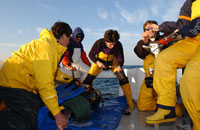The Tag-A-Giant team is pleased to report that some of our Pacific bluefin tuna tagging research was published today in one of the world's preeminent scientific journals, Nature. Data from over 300 recaptured archival-tagged bluefin were included in a landmark study, the Census of Marine Life Tagging of Pacific Predators (TOPP) project. TOPP was a whirlwind 10-year research initiative in which 75 scientists from 5 countries deployed 4,306 tags on 23 species in the North Pacific, resulting in a tracking dataset of unprecedented scale and species diversity. Over 1,500 of the tags were deployed on tunas - 655 bluefin, 582 yellowfin and 296 albacore tuna. TAG's Scientific Advisor, Dr. Barbara Block, professor at Stanford University, was co-founder of TOPP and is the paper's lead author.
 Figure 1. Positions of all TOPP animals, color-coded based on species group: blue - tunas (yellowfin, bluefin and albacore), orange - pinnipeds (northern elephant seals, California sea lions and northern fur seals), red - sharks (salmon, white, blue, common thresher and mako), purple - seabirds (Laysan and black-footed albatrosses and sooty shearwaters), green - sea turtles (leatherback and loggerhead) and black - cetaceans (blue, fin, sperm and humpback whales).
Figure 1. Positions of all TOPP animals, color-coded based on species group: blue - tunas (yellowfin, bluefin and albacore), orange - pinnipeds (northern elephant seals, California sea lions and northern fur seals), red - sharks (salmon, white, blue, common thresher and mako), purple - seabirds (Laysan and black-footed albatrosses and sooty shearwaters), green - sea turtles (leatherback and loggerhead) and black - cetaceans (blue, fin, sperm and humpback whales).
To date, recapture rates of over 50% on the archival-tagged Pacific bluefin have yielded the world's largest electronic tag dataset - over 66,000 days in the life of Pacific bluefin tuna. Major results presented in today's paper include a description of how some young bluefin tuna migrate from their birthplace near Japan to the waters off the West Coast where they display residency within California Current for a number of years. They then migrate back to their birthplace along the trans-oceanic migration highway called the North Pacific Transition Zone.
“How or why a young bluefin tuna less than two years of age wakes up in the light of the Japan sea and decides to swim to Baja remains completely unknown,” says Dr. Block. “Once they get here, tagging data indicate they reside for years, taking advantage of the rich forage off North American coastlines. These tunas become vulnerable to oceanic fisheries across the Pacific during both this highly migratory period and this retentive period lunching on our coast.”
A more concerning result of the study relates to the high rates of tag return - this is great for the science but also unfortunately indicates high fisheries mortality. TAG scientists are now using the tagging data to develop a stock assessment model for Pacific bluefin tuna to determine the status of the species and assess whether the current fishing effort is sustainable.
For more information on TOPP and the Nature paper, click here.
 Figure 1. Positions of all TOPP animals, color-coded based on species group: blue - tunas (yellowfin, bluefin and albacore), orange - pinnipeds (northern elephant seals, California sea lions and northern fur seals), red - sharks (salmon, white, blue, common thresher and mako), purple - seabirds (Laysan and black-footed albatrosses and sooty shearwaters), green - sea turtles (leatherback and loggerhead) and black - cetaceans (blue, fin, sperm and humpback whales).
Figure 1. Positions of all TOPP animals, color-coded based on species group: blue - tunas (yellowfin, bluefin and albacore), orange - pinnipeds (northern elephant seals, California sea lions and northern fur seals), red - sharks (salmon, white, blue, common thresher and mako), purple - seabirds (Laysan and black-footed albatrosses and sooty shearwaters), green - sea turtles (leatherback and loggerhead) and black - cetaceans (blue, fin, sperm and humpback whales).To date, recapture rates of over 50% on the archival-tagged Pacific bluefin have yielded the world's largest electronic tag dataset - over 66,000 days in the life of Pacific bluefin tuna. Major results presented in today's paper include a description of how some young bluefin tuna migrate from their birthplace near Japan to the waters off the West Coast where they display residency within California Current for a number of years. They then migrate back to their birthplace along the trans-oceanic migration highway called the North Pacific Transition Zone.
“How or why a young bluefin tuna less than two years of age wakes up in the light of the Japan sea and decides to swim to Baja remains completely unknown,” says Dr. Block. “Once they get here, tagging data indicate they reside for years, taking advantage of the rich forage off North American coastlines. These tunas become vulnerable to oceanic fisheries across the Pacific during both this highly migratory period and this retentive period lunching on our coast.”
A more concerning result of the study relates to the high rates of tag return - this is great for the science but also unfortunately indicates high fisheries mortality. TAG scientists are now using the tagging data to develop a stock assessment model for Pacific bluefin tuna to determine the status of the species and assess whether the current fishing effort is sustainable.
For more information on TOPP and the Nature paper, click here.



